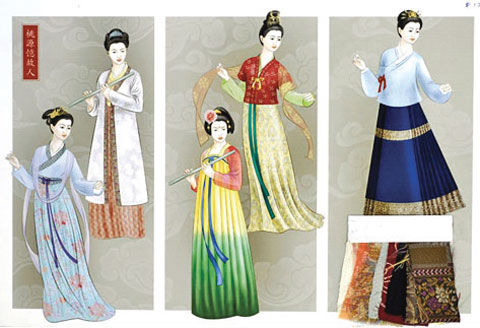
Oct 25 , 2023
hanfu is the generic name for traditional Chinese dress.
hanfu is the generic name for traditional Chinese dress.

The relatively popular hanfu are mainly divided into four systems: Han, Tang, Song and Ming. Looking back at the beautiful costumes in the past, in terms of women's costumes, for example, there are Han's deep and subtle, Tang's gorgeous and novel, Song's simple and fresh, and Ming's soft and natural, and all of them are the treasures of the traditional costume culture that have been accumulated in the exchange of cultures of various sources, with elegant styles and rich connotations.
Han Dynasty.
Clothing has formed the characteristics of cross-neck and right overlapping.
The most influential items of clothing in the Han Dynasty are the deep garment and the upper garment and lower garment. These two types of clothing in the Warring States period has matured, are inherited since the Shang and Zhou Dynasty, the formation of cross-necked, right overlooking, lapel belt basic structural features. During the Western Han Dynasty, the deep garment, which was worn by both men and women, was mostly used as a dress. As the form of trousers was still immature, only similar to modern trousers in the leg like shin, in order to cover the body, deep clothes lapel corner of the sash can be tied at the waist, wearing the waist and hips can be tightly wrapped. In order to facilitate the wearer in a deep coat can also walk freely, the Han Chinese will be designed for the lapel train, from front to back, layers of winding.
Tang Dynasty.
Attire accentuated the breasts and lengthened the legs, typical of the traditional dresses: qixiongruqun and qunyaoqun.
By the Tang Dynasty, the most common women's attire was the short jacket or large-sleeved blouse paired with a long skirt, with half-arms and cape. The short jacket of the Tang Dynasty was mainly made with a pair of lapels and narrow sleeves, with a varied neckline, the lapels were open and unbuttoned, and the sleeves were long enough to reach the wrists to cover the hands; the large-sleeved shirt was long enough to reach below the hips, and the hemline was often draped over the body of the skirt. The waistline of this kind of attire is obviously higher than the natural waistline of human body, highlighting the chest and lengthening the legs, creating a good opportunity for the design of skirts.
Song Dynasty.
Clothing seeks to be slender and fit
In the Song Dynasty, the trend of Tang dresses took a clear turn for the worse. "Narrow Luo shirt and thin Luo skirt, small waist, new evening make-up" should be from the late Tang Dynasty to open a new chapter of aesthetics. Song Dynasty dress seeks to slender and fit, women's daily dress has a big-sleeved shirt, pasted, half-arm, jacket, jacket, skirt, trousers, etc., the main underwear chest and wrapped belly. Pasted together is also written as "back", which is the basic and common style of women's clothing in Song Dynasty.
The Song dynasty, such as pleated skirts and other skirts, general waist skirt for the normal waistline height, tied to the belt with a ribbon ring. The style of the formation of modern popular mamianqun, can be seen in the China Silk Museum in Jiangxi De'an Zhou's tomb unearthed a waist skirt.
Ming Dynasty
Combining elements of the Tang Dynasty and Mongolian culture, the basic style of Ming clothing was inherited from both the Tang and Song dynasties, as well as borrowed from the Mongol Yuan. Women's daily costumes mainly included shirts, jackets, capes, pasties, bikinis, skirts, and so on. The Ming Dynasty pasted with the form and pasted roughly the same. Than the armour for the Ming Dynasty absorbed the Mongolian dress, and the pasties similar shape, lapel sleeveless, length and skirt equivalent. In the Ming Dynasty women commonly wore, retained the custom of ruqun, there are also long clothes and short skirts with.
Each hanfu dynastic system of hanfu has a unique charm. If you are also a hanfu lover, I am sure you would like to come and learn more about traditional Chinese dress.


